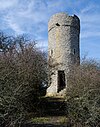Waiting towers in Lower Franconia
The waiting towers in the Rhön are a series of waiting towers on Rhön-Grabfelder (or at Münnerstadt on Bad Kissinger ) Grund on the east side of the Rhön. Their main task was to secure the area and to alert the community in case of danger.
The structurally similar waiting towers in the district of Fulda are located around the city of Fulda in the western part of the Rhön.
design type
All towers have in common that the relatively small entrance is a few meters above the ground and it always faces a town . By loopholes and partly a surrounding wall there is the possibility to defend themselves. As a rule, the waiting towers were built from rubble stones , which are held together with mortar . Almost all of them are now provided with steps up to their entrance, previously the ascent to the entrance was only possible with ladders. The floor of the first floor is made up of rubble and rubble that was of no importance during construction. The last meters to the "roof" can be reached via ladders and intermediate floors, which are made of wood or, less often, of metal. The "roof" usually consists of a brick layer. In recent times, a concrete floor has often been poured on this, an additional wall has been installed and a hole has been broken to reach it. Because of the mostly low visual obstruction, this part of the tower usually provides the best view . It was mostly unusual for a watch tower to have a surrounding wall.
purpose
As a rule, it was less important to defend oneself militarily, but rather, and this is also supported by the fact that it is a network of towers, to keep watch and, if necessary, to alarm . The secondary task is to keep a fire watch while the fields are being tilled. Very few of the guards will have held out to the last man, but are, and hence the term, piled up . Initially, it was assumed that the towers around Ostheim and Mellrichstadt had a connection to Lichtenburg , which can no longer be proven, but visual contact does not completely falsify this.
List of towers
Medieval tower hill. 2300 m wnw of the church of Wollbach. "Ochsenbühl" corridor; Wollbach FlstNr. 518-520; NW 107-42; NW 107-43; Find no. 5627/0050.
Individual evidence
- ↑ a b From thin and thick towers on rhoenline.de; Retrieved April 26, 2016










